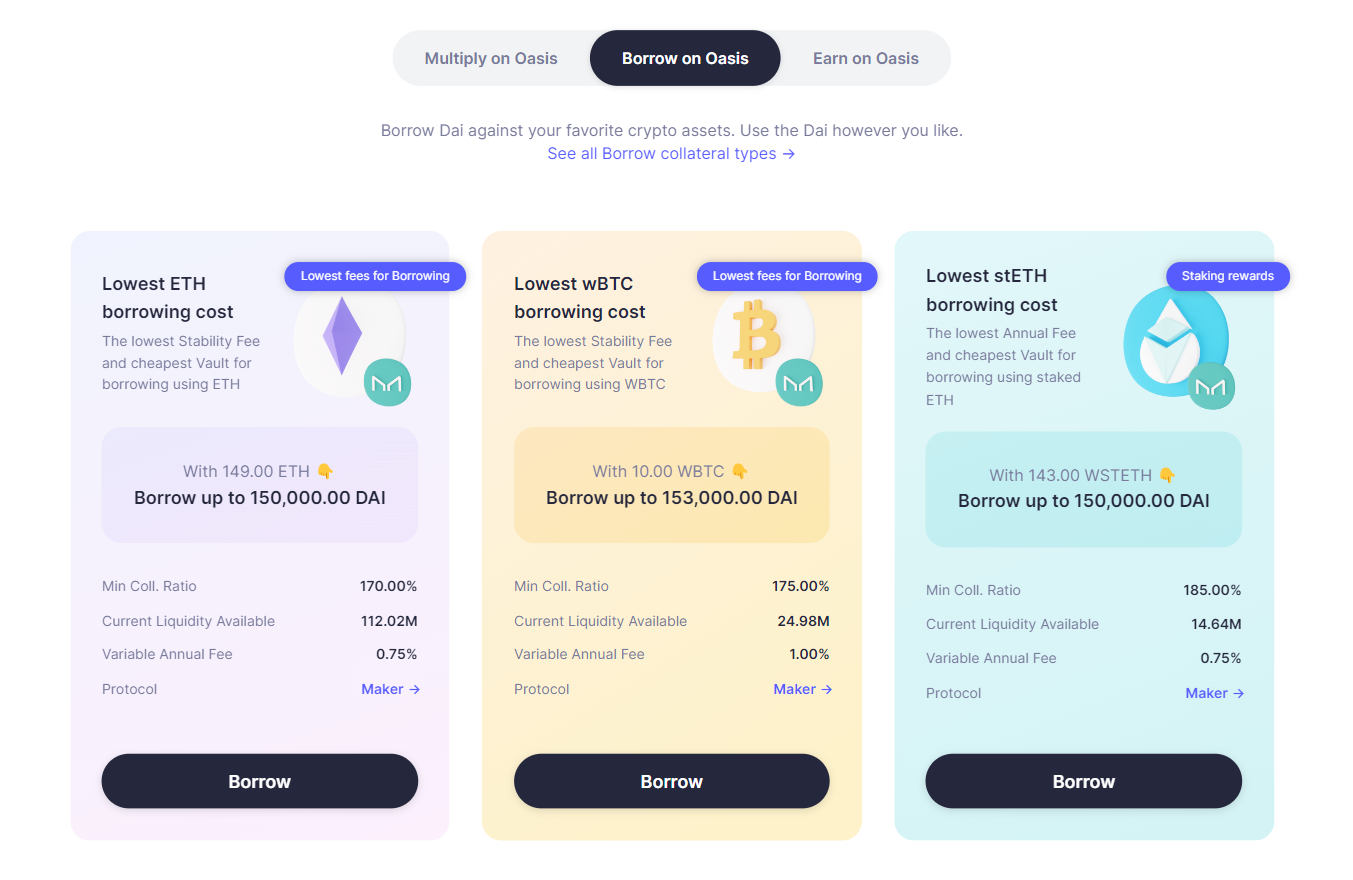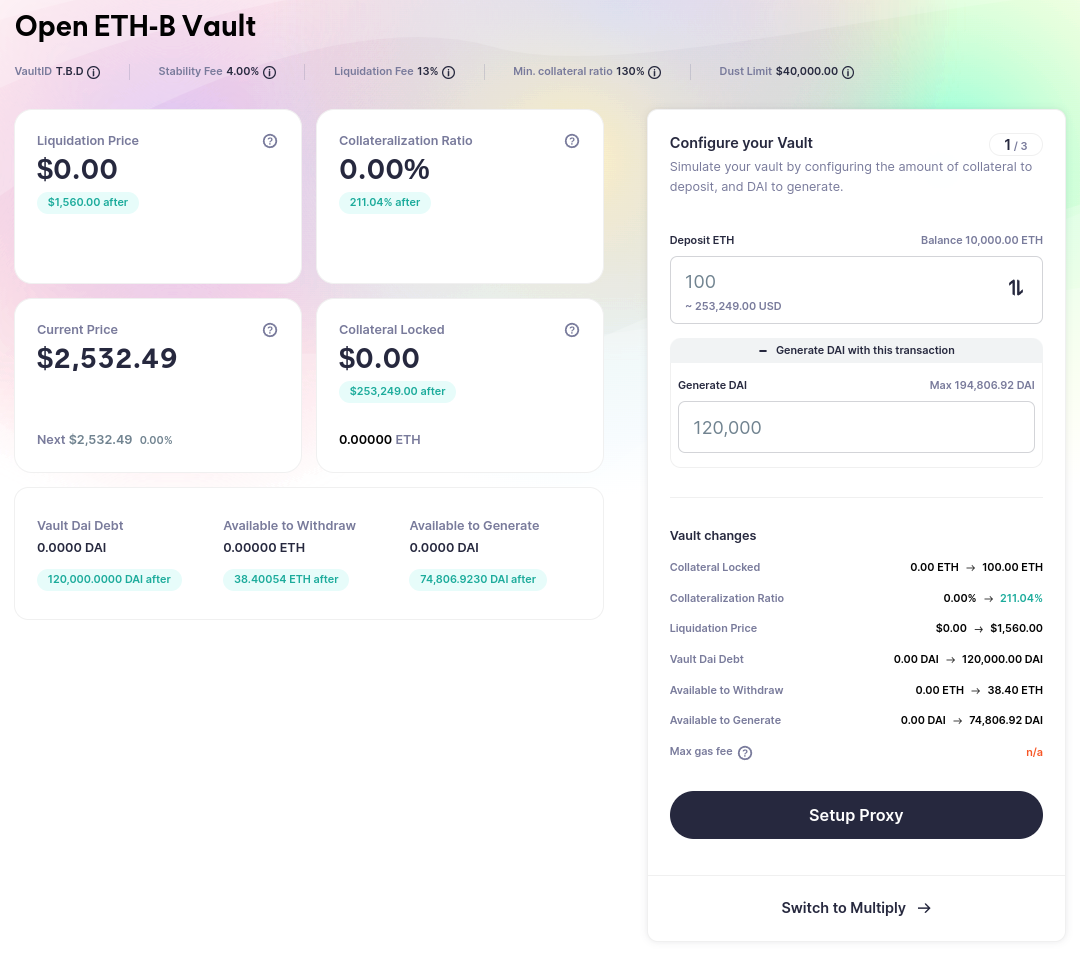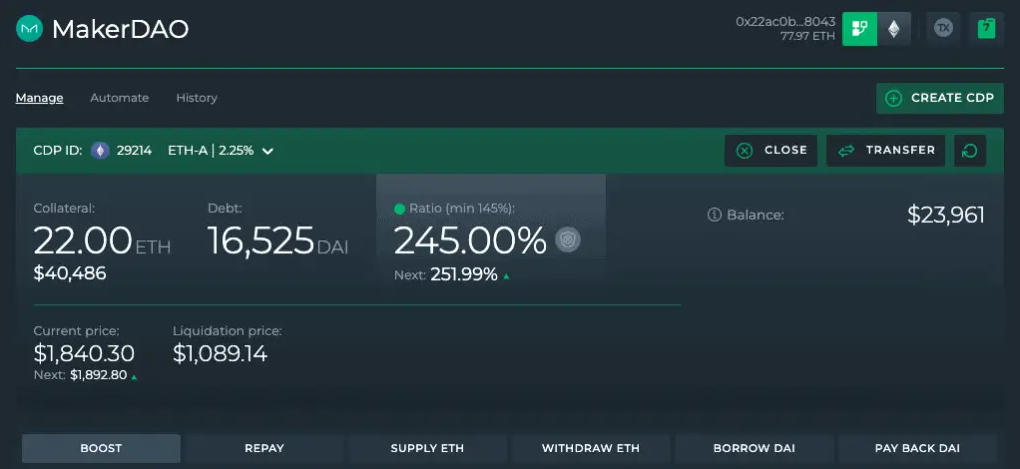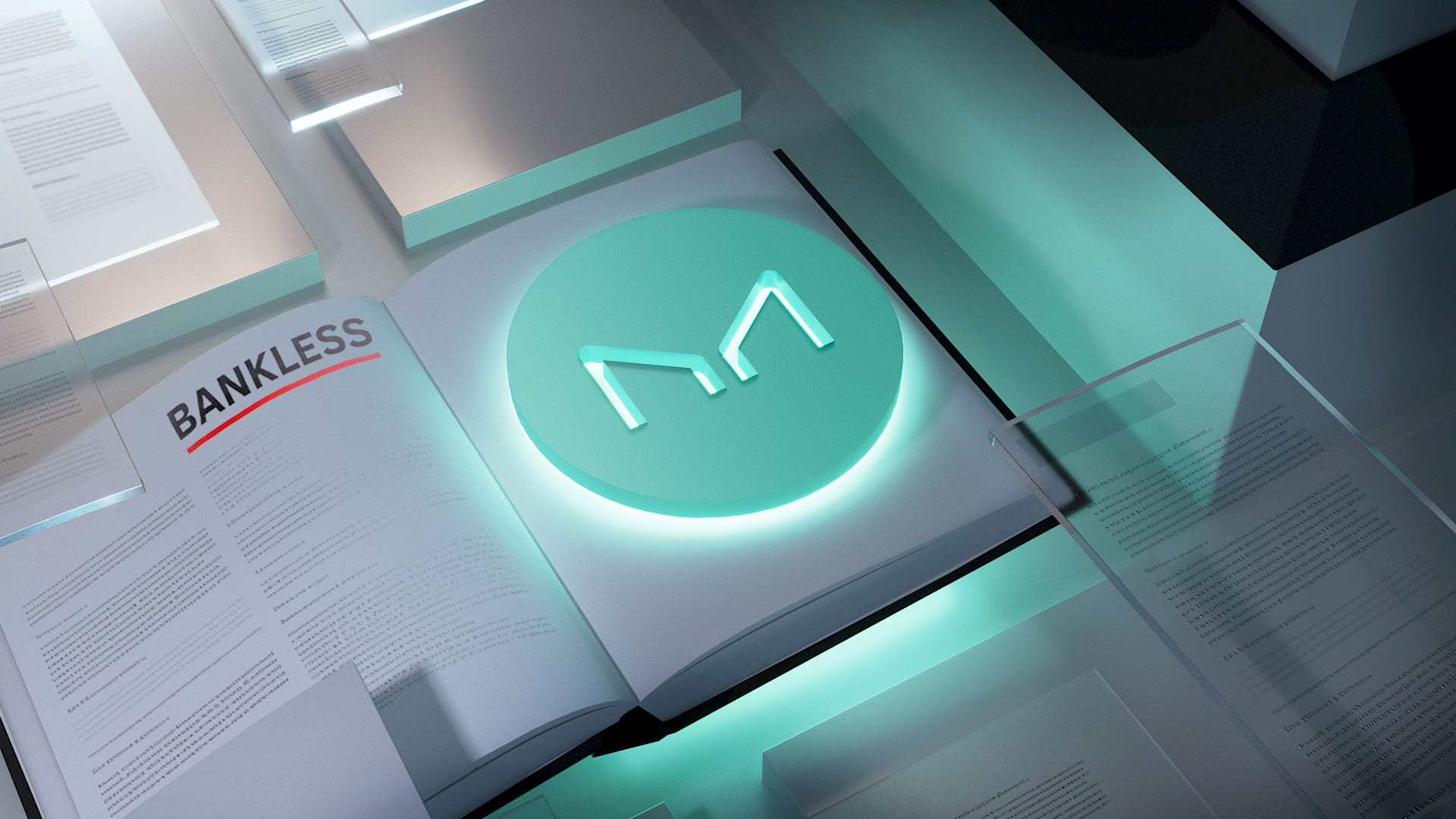Most commonly referred to as “Maker,” MakerDAO is a decentralized autonomous organization (DAO) that operates on Ethereum and is best known for creating the Dai stablecoin and being one of the pioneering borrowing protocols of decentralized finance (DeFi).
Maker fundamentally exists to provide a stablecoin that is pegged to the value of the US dollar, while also being transparent and decentralized. Its smart contract system uses collateralized debt positions (CDPs) known as “Maker Vaults” to maintain the stable value of Dai, with users depositing ETH and other tokens as the underlying collateral.
Beyond actualizing the Dai stablecoin, borrowing against crypto on Maker offers a series of unique advantages compared to borrowing money through a traditional financial institution. These advantages include:
- ⛓️ Decentralization: There is no central authority or middleman involved in the lending process, which reduces costs and increase transparency.
- 🙌 Accessibility: Unlike traditional bank loans, which may require extensive paperwork and credit checks, Maker loans are accessible to anyone with an Ethereum wallet. This means that individuals who may not have access to traditional banking services can still access loans through Maker.
- 🛡️ Security: Maker loans are secured by overcollateralization in the form of ETH or other supported crypto, which reduces the risk of default for the protocol. Additionally, Maker’s smart contracts are transparent and battle-tested, which provides additional assurances.
- ➰ Flexibility: Maker lets borrowers repay their loans at whatever pace they please, providing more control over how they manage their finances.
- 🪙 HODLing: If you want some spending money but don’t want to sell your crypto, borrowing Dai through Maker is a straightforward way to do so in DeFi.
History of Maker
First ideated in 2014 by Danish entrepreneur Rune Christensen and then finally launched in December 2017, Maker is one of the oldest and most proven apps in DeFi and still remains widely used today.
When it first began, Maker only supported ETH as collateral for Dai borrow positions. This system later came to be known as Single Collateral Dai (SCD) and was phased out in favor of Multi-Collateral Dai (MCD), which allowed for ERC20 tokens to be approved as Maker collateral types, in November 2019.
Also in 2019, Maker notably launched Oasis as the premiere frontend for opening Maker Vaults and managing Dai borrow positions. Since then Oasis has been spun off into an independent project, but it remains the most popular way for end users to directly interact with the Maker protocol.
Looking ahead, Maker is currently in the process of its Endgame transformation, an overhaul toward self-sustainability that will see DAI and MKR holders able to opt-in to new coins, which are yet to be named and released. The project is currently considering conducting a fork of Solana to create the "backend" needed to power the Endgame vision.
The pulse of Maker
At the time of this guide’s latest update (September 2023), Maker was the 2nd-largest app in DeFi per its $4.66B in current total value locked (TVL).
Notably, the entirety of this TVL exists on Ethereum as that’s the only chain Maker is deployed on. At its latest peak in December 2021, Maker’s TVL was as high as ~$20B.

As for Dai, the stablecoin currently has a market cap of $5.42B, making it the 3rd-largest stablecoin in the cryptoeconomy at the moment behind only Tether (USDT), USD Coin (USDC), and Binance USD (BUSD).
This $5.42B market cap currently exists across +30 different chains, since bridges make the transfer of tokens to other networks compatible with the Ethereum Virtual Machine (EVM) simple. To review the current state of Dai at any given time and the stablecoin’s most important stats, consider checking out the excellent overview resource daistats.com.

Maker’s tokens
At this point you’re generally familiar with the Dai stablecoin. It’s pegged to $1 USD and aims to provide a decentralized avenue for stable savings and stable payments as a buffer against the volatility of crypto markets. In this way, Dai is the Maker protocol’s medium of exchange (MoE) and unit of account (UoA).
However, Maker is a dual-token project. MKR the governance of Maker, as it allows holders to participate in the decision-making processes of the DAO, such as voting on new collateral types or changes to Dai borrowing fees. Accordingly, MKR holders are ultimately responsible for maintaining the Maker protocol and the stability of Dai.
What you need to use Maker
- 👛 A wallet — since Maker is deployed on Ethereum, virtually any Ethereum compatible wallet should suffice for use with the protocol
- 🪙 Starter gas — you’ll need some ETH to cover the gas costs
- 💰 Collateral — the minimum amount you can borrow through a Maker Vault right now is 3,500 DAI, so you will need to have enough collateral in your crypto of choice, e.g. ETH, to overcollateralize your borrow
How to use Maker

Are you a long-term holder in need of some extra liquidity for life expenses, but don't want to sell any of your ETH, UNI, etc.?
Here you could consider starting with Oasis, the aforementioned popular Maker frontend that makes it simple to create DeFi self-loans. By configuring a Maker Vault via Oasis Borrow, you can draw DAI liquidity against your collateral and then sell the DAI as needed, paying back the loan over time on a schedule that works for you.

To get started, you can check out this complete tutorial for a step-by-step guide to the onboarding process. Just be sure to avoid liquidation by ensuring your Vault remains adequately collateralized along the way. Toward this end, Oasis offers automated buys/sells and stop-loss protection for managing your positions passively.
Risks of Maker
Like with any cryptoeconomic system, there are risks associated with using Maker and the Dai stablecoin. Some of the main risks to be aware of include:
- Collateral volatility: Maker loans are collateralized with ETH or other tokens, which can be volatile in price. If the value of your collateral drops significantly, it can trigger a liquidation event, where your collateral is sold off to cover your outstanding debt. This will result in loss of funds.
- Smart contract risk: Maker relies on smart contracts to function. While Maker’s smart contracts are among the most battle-tested and proven in all of crypto, it’s impossible to rule out the possibility of a currently unknown vulnerability lying dormant in the protocol, however remote the chance of that is now.
- Regulatory risk: The regulatory landscape for DeFi is uncertain and in flux in many jurisdictions, so there’s the possibility that regulatory actions against DeFi or against Maker directly could negatively affect the protocol.
- Market risk: For example, in the market chaos at the start of the COVID pandemic the Dai stablecoin depegged and climbed from $1.00 to $1.11, while in the more recent USDC Silvergate fallout DAI temporarily traded as low as $0.88 amid the drama. As such, market risks can strain the DAI peg.
- Governance risk: Maker’s decentralized management relies on the MKR governance system, and if this system stagnates or is compromised the protocol and its users will be negatively impacted.
It's important to keep these risks in mind when using Maker and Dai, and to carefully consider your risk tolerance and crypto goals before getting involved. By staying informed and practicing good risk management strategies, you can help mitigate these risks and use these DeFi tools with confidence.
Other apps you can use with Maker
In the DeFi borrowing sector, there’s a sub-category of projects known as “smart dashboards,” i.e. advanced DeFi management platforms.
Two notable projects in this vertical are DeFi Saver and Instadapp, both of which can help you take your Maker management capabilities to the next level with a range of different advanced functionalities. To use one of your existing Maker Vaults with either of these platforms, you will need to “migrate” it into their overlaying protocols, which will cost gas.

DeFi competitors to Maker
While Maker was the first protocol of its kind live on Ethereum, there are now a range of popular DeFi borrowing protocols in the cryptoeconomy. The largest of these projects include:
Additional Maker resources
If you're looking to expand your knowledge and explore the world of MakerDAO, there are plenty of supplementary resources available. Here are a few worth checking out:
Zooming out
Maker is a pioneering project in DeFi that continues to offer users the ability to create Dai loans and borrow against their crypto collateral in an accessible, decentralized, and transparent manner. While there are risks associated with using Maker and Dai, such as market risks, the platform remains one of the most trusted DeFi platforms as evidenced by its current $4.66B TVL.
Looking ahead, the Maker community has been exploring deeper integrations with real world assets (RWAs), which pose both opportunities and risks to the protocol. While there is still much work to be done here, the potential benefits of such integration could be significant. As the Maker community continues to navigate this complex landscape, it will be important to balance innovation and risk management to ensure the long-term success of the protocol and the Dai stablecoin.

